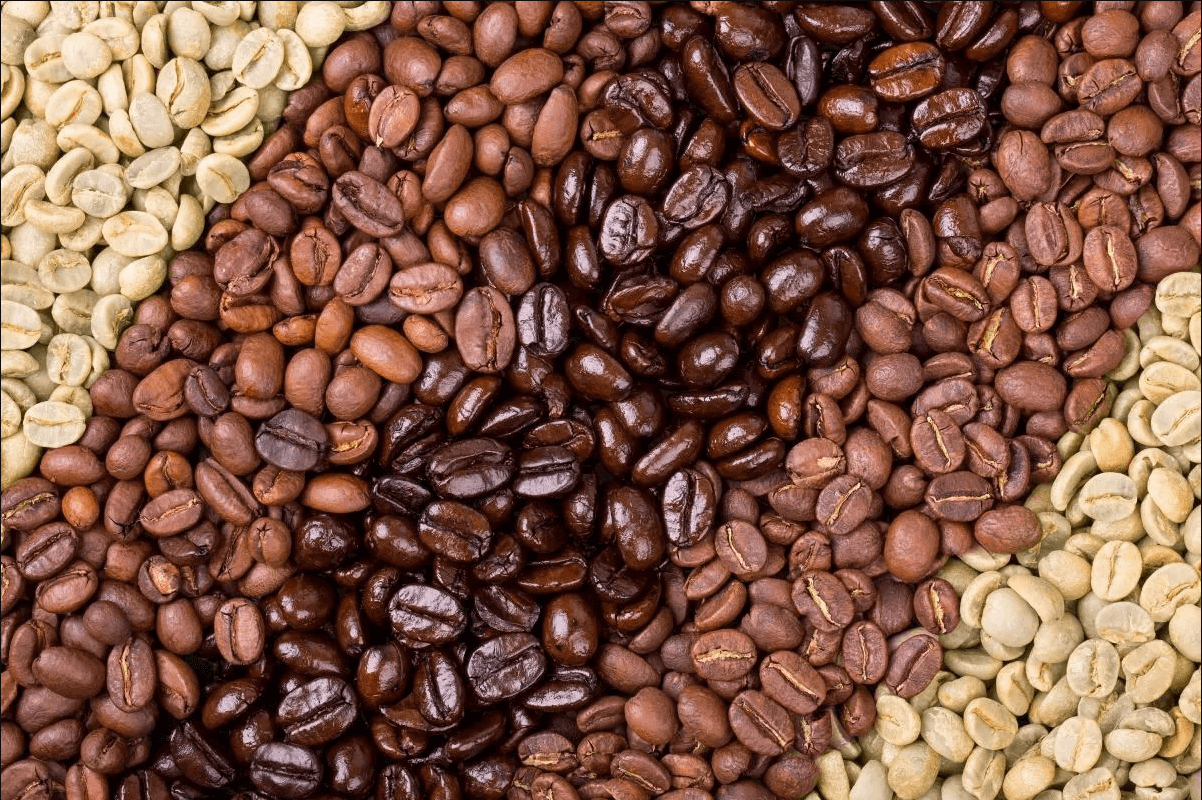
You’re not alone if you’ve ever felt overwhelmed in the grocery store coffee aisle. City, French, Viennese, Cinnamon — there are hundreds of varieties of coffee and almost as many types of roasts!
Though the bean matters, coffee gets much of its aroma and flavor from roasting. The length of the roasting process can affect many things, including the body, acidity, and flavor of your tasty beans. To help you expand your coffee knowledge, we’ve compiled this handy guide to the four major types of coffee roasts.
The four types of coffee roasts are light roast, medium roast, medium-dark roast, and dark roast. Each of these roast levels has a different aroma, appearance, and flavor. Keep reading to learn all about the four types of coffee roasts!
The 4 Types of Coffee Roasts:
1. Light Coffee Roasts

Light roasts are roasted for the least amount of time. Lightly roasted beans generally reach an internal temperature of 356°F – 401°F right after the first crack occurs. These beans tend not to have the oils on them because they haven’t been roasted at a high enough temperature.
The longer a bean is roasted, the more the heat pulls out the caffeine and the acidity. This means light roasts have the most caffeine (by volume) and the most acidity. Light roasts can have a different taste profile because the shortened roasting process prevents some chemical changes from occurring inside the bean. Origin flavors of the bean are more recognizable in light roasts since the flavors that come from the roasting process often aren’t prominent. The acidity in light roasts is often accompanied by a citrus or lemon tone, which some people find pleasing to the palate.
2. Medium Coffee Roasts

Medium roasted coffee reaches internal temperatures of 410°F-428°F. This is after the first crack and just before the second one occurs. They have a little bit more body than a light roast and less acidity.
Medium roasts are what the average American coffee drinker is used to. These roasts are considered to have balanced flavors. The acidity and body of a medium roast can vary but are usually somewhere in the middle. Some examples of medium roasts are House blend, Breakfast roast, and American Roast.
3. Medium-Dark Coffee Roasts

Beans roasted to medium-dark reach an internal temperature of 437°F – 446°F. This is during or just after the second crack. This roast will also start showing the oils on the beans’ surface because the temperatures are high enough.
These roasts have a richer, fuller flavor, more body, and less acidity. Vienna Roast and Full-City Roast are some examples of a medium-dark roast coffee blend.
4. Dark Coffee Roasts

The roasting temperature for a dark roast is between 464°F – 482°F. There are visible oils on dark roast beans. Typically you cannot taste any origin flavors in a dark roast, just the roasting process’s effects on that type of coffee bean.
Dark roasts have sweeter flavors because the sugars in the coffee beans have time to caramelize. The longer roasting process helps it develop a richer flavor and full body, which often leads to a buttery finish. They also have the slight acidity of all coffee roasts. Dark roasts have the least caffeine because they’re roasted the longest. French roast is considered the darkest roast and has a pronounced smoky flavor. If coffee beans are roasted longer than a French roast (482°F), the oils and sugars in the bean will burn. Dark roasts often have European names because of the popularity of dark roasts in Europe, such as Italian roasts.
What does the roasting process do?

The roasting process toasts the coffee beans, darkening their color and giving them chocolatey, caramelized flavors. At higher temperatures, oils appear on the surface of the beans. At 401°F, the beans crack for the first time and start to expand. Around 437°F, they crack a second time. High-quality coffee beans are never roasted above 482°F. Beyond that temperature, they will begin to thin out and get a burnt taste. You don’t want to drink charcoal!
Roast names and descriptions are not universal in the coffee industry, and roasting is part art and part science. All that variation can make picking the right bean bag a little tricky. However, you should be able to tell the roast level by the color of the bean and what it tastes like.
Coffee Roasting: Final Thoughts
There you have it: the four major types of coffee roasts and all about the roasting process. You’re ready to pick out a bag of beans, order a cup with confidence, or even try roasting coffee at home! And if you’re stuck on just one type of roast, try something new. Trust us: you’ll be surprised at the differences you taste.





